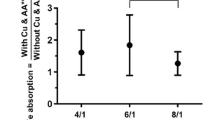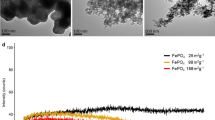Abstract
To measure the effect of acute copper (Cu) administration, given as an aqueous solution, on the absorption of iron (Fe), 29 healthy adult women participated in two iron absorption studies. Subjects received 0.5 mg of Fe, as ferrous sulfate, alone or with Cu, as copper sulfate, at 0.5:1, 1:1, or 2:1 Cu/Fe molar ratios (study I) or at 4:1, 6:1, or 8:1 Cu/Fe molar ratios (study II) as an aqueous solution on days 1, 2, 14, and 15 of the study. Fe absorption was assessed by erythrocyte incorporation of iron radioisotopes 55Fe and 59Fe. Geometric mean (range ± SD) absorption of Fe alone or at 0.5:1, 1:1, 2:1 Cu/Fe molar ratios were 34.4% (17.3–68.5%), 40.9% (24.9–67.2%), 48.3% (24.8–94.1%), and 50.2% (25.3–99.5%), respectively (ANOVA, p = 0.12). Geometric mean (range ± SD) absorption of Fe alone or at 4:1, 6:1, 8:1 Cu/Fe molar ratios were 28.7% (12.1–67.9%), 21.5% (6.5–71.5%), 29.6% (10.3–85.4%), and 36.5% (18.3–73.1%), respectively (ANOVA, p = 0.16). In conclusion, combined Cu and Fe administration in an aqueous solution does not inhibit Fe bioavailability. This information could help in the design of rational guidelines for copper and iron supplementation programs. Our results support the hypothesis that divalent metal transporter 1 is not physiologically relevant for copper absorption in humans.

Similar content being viewed by others
Abbreviations
- Cu:
-
Copper
- Fe:
-
Iron
- Hb:
-
Hemoglobin
- MCV:
-
Mean cell volume
- ZPP:
-
Zn-protoporphyrin
- Sat:
-
Transferrin saturation
- RBC:
-
Red blood cells
- SF:
-
Serum ferritin
- DMT1:
-
Divalent metal transporter 1
References
DeMaeyer E, Adiels-Tegman M (1985) The prevalence of anaemia in the world. World Health Stat Q 38:302–316
Olivares M, Walter T, Hertrampf E, Pizarro F (1999) Anaemia and iron deficiency disease in children. Br Med Bull 55:534–548
Solomons N, Ruz M (1997) Zinc and iron interaction: concepts and perspectives in the developing world. Nutr Res 17:177–185
Olivares M, Uauy R (1996) Copper as an essential nutrient. Am J Clin Nutr 63:791S–796S
Fischer DS, Price DC (1964) A simple serum iron method using the new sensitive chromogen tripyridyl-s-triazine. Clin Chem 10:21–31
Gunshin H, Mackenzie B, Berger UV, Gunshin Y, Romero MF, Boron WF, Nussberger S, Gollan JL, Hediger MA (1997) Cloning and characterization of a mammalian proton-coupled metal-ion transporter. Nature 388:482–488
Arredondo M, Muñoz P, Mura CV, Núñez MT (2003) DMT1, a physiologically relevant apical Cu1+ transporter of intestinal cells. Am J Physiol Cell Physiol 284:C1525–1530
Lee J, Peña MM, Nose Y, Thiele DJ (2002) Biochemical characterization of the human copper transporter Ctr1. J Biol Chem 277:4380–4387
Knöpfel M, Smith C, Solioz M (2005) ATP-driven copper transport across the intestinal brush border membrane. Biochem Biophys Res Commun 330:645–652
Zerounian NR, Linder MC (2002) Effects of copper and ceruloplasmin on iron transport in the Caco 2 cell intestinal model. J Nutr Biochem 13:138–148
Arredondo M, Martinez R, Nunez MT, Ruz M, Olivares M (2006) Inhibition of iron and copper uptake by iron, copper and zinc. Biol Res 39:95–102
Tandy S, Williams M, Leggett A, Lopez-Jimenez M, Dedes M, Ramesh B, Srai SK, Sharp P (2000) Nramp2 expression is associated with pH-dependent iron uptake across the apical membrane of human intestinal Caco-2 cells. J Biol Chem 275:1023–1029
Tennant J, Stansfield M, Yamaji S, Srai SK, Sharp P (2002) Effects of copper on the expression of metal transporters in human intestinal Caco-2 cells. FEBS Lett 527:239–244
INACG (1985) Measurement of iron status. A report of the International Anemia Consultative Group (INACG). The Nutrition Foundation, Washington
Eakins JD, Brown DA (1966) An improved method for the simultaneous determination of iron-55 and iron-59 in blood by liquid scintillation counting. Int J Appl Radiat Isot 17:191–197
Nadler SB, Hidalgo JU, Bloch T (1962) Prediction of blood volume in normal human adults. Surgery 51:224–232
Bothwell TH, Finch CA (1962) Iron metabolism. Little Brown, Boston
Garrick MD, Singleton ST, Vargas F, Kuo HC, Zhao L, Knopfel M, Davidson T, Costa M, Paradkar P, Roth JA, Garrick LM (2006) DMT1: which metals does it transport? Biol Res 39:79–85
Acknowledgments
This research was supported by the grant 1070665 from FONDECYT–Chile. We thank Ms. Angélica Letelier for her technical assistance in the laboratory.
Author information
Authors and Affiliations
Corresponding author
Rights and permissions
About this article
Cite this article
Olivares, M., Pizarro, F., de Romaña, D.L. et al. Acute Copper Supplementation Does Not Inhibit Non-Heme Iron Bioavailability in Humans. Biol Trace Elem Res 136, 180–186 (2010). https://doi.org/10.1007/s12011-009-8536-1
Received:
Accepted:
Published:
Issue Date:
DOI: https://doi.org/10.1007/s12011-009-8536-1




